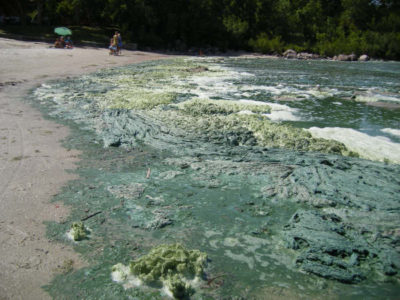Preparing for Algal Blooms – What You Should Know
Download
Fact Sheet on Blue-green Algal Blooms
Download
Poster - Blue-green Algal Bloom Precautions

Blue-green algae (cyanobacteria) are a type of algae that can produce toxins that can be harmful to people, pets and livestock. Algal blooms, or the overgrowth of algae, can occur in lakes and other surface waters. Warm and calm weather combined with high levels of nutrients (phosphorus and nitrogen) during the summer months can create ideal conditions for algal bloom development.
Algal blooms will form floating clumps or scums, sometimes making the water look like thick pea soup or paint, and may emit a strong, unpleasant odour. However, not all algal blooms produce toxins, and there is no visual way to detect if toxins are present in the water.
Home and cottage owners who use lake water as a source of drinking water should be aware that most small residential treatment systems are unable to remove algal toxins. Boiling or adding chlorine to the water will not remove the algal toxins.
What are the Symptoms of Algal Toxin Exposure?
Symptoms of algal toxin exposure may include: nausea, vomiting, headache, diarrhea, skin/eye irritation, fever, muscle and joint pain, respiratory symptoms, allergic reactions and occasionally other more severe health effects. Algal toxin exposure has resulted in animal deaths in Manitoba.
If you experience symptoms that may be related to algal toxins, please see your health care provider. Contact Health Links – Info Santé at 204-788-8200 (toll free at 1-888-315-9257) if you are concerned about health effects.
What You Can Do
If you have an infant: As a precaution, avoid using water from small private surface water systems to prepare infant formula during the summer months. Infant formula should be prepared using a safe alternate drinking water source (such as bottled water).
Watch your lake for algal blooms. If you observe an algal bloom, take the following precautionary measures:
- Avoid drinking, swimming or bathing in water with algal blooms.
- If an algal bloom is observed on the lake that supplies your small water system, use an alternate water source (such as bottled water) for drinking, food preparation, bathing, other personal hygiene and pets.
- If you are visiting a beach, avoid swimming or bathing in water if you see an algal bloom. Manitoba routinely monitors public beaches for algal blooms and posts beach advisories when concentrations pose a health risk.
- Keep pets and livestock out of the water if you see an algal bloom.
- Algal toxins can accumulate in fish, particularly in the internal organs, like the liver and kidneys. Avoid consuming the internal organs of fish and avoid consuming fish that appear unhealthy in waters experiencing algal blooms.
- Notify your neighbours and report the algal bloom at manitoba.ca/beaches or 204-945-0002.
For More Information
For more information on beach conditions and algal blooms, please contact the Water Science and Watershed Management Branch at 204-945-0002 or visit the website at manitoba.ca/beaches.
For more information on algal toxins in drinking water, please contact the Office of Drinking Water at 204-945-5762 or visit the website at manitoba.ca/drinkingwater.
For information on your municipal drinking water system, contact your water supplier.
